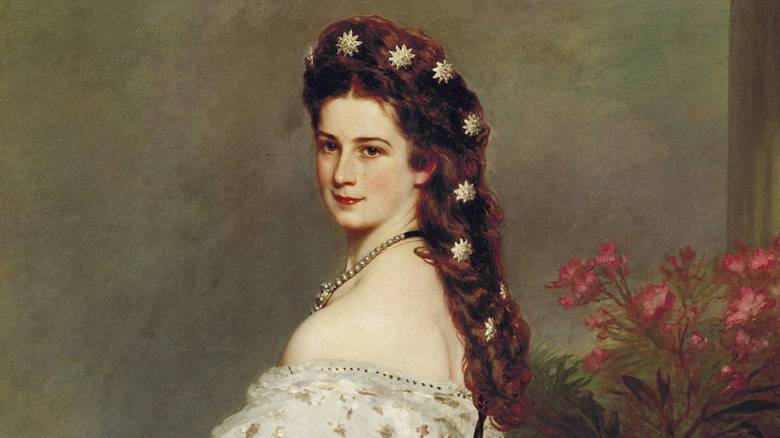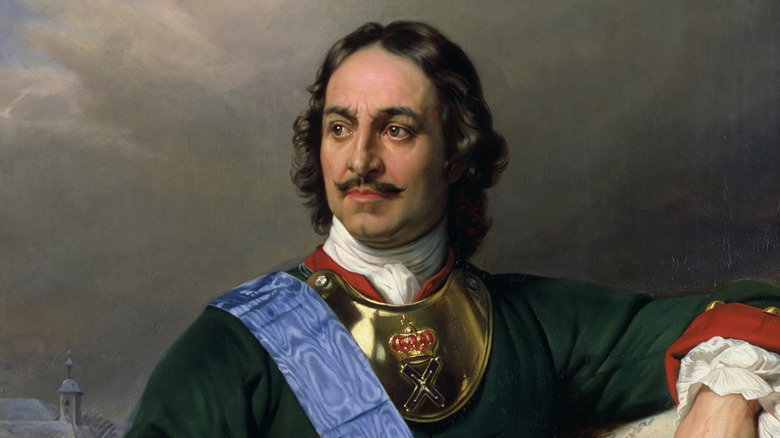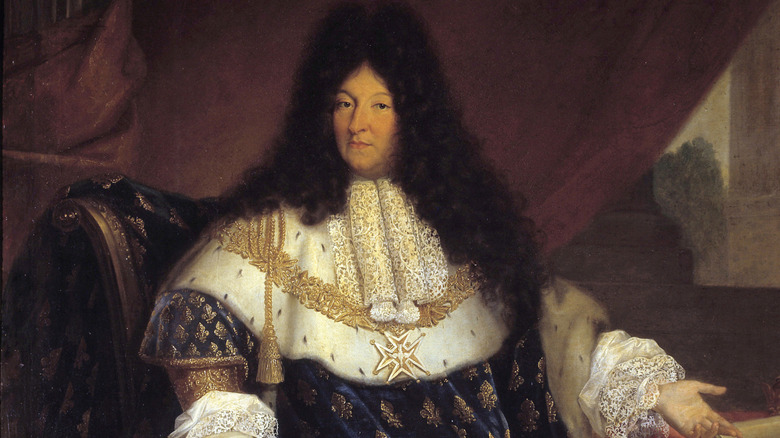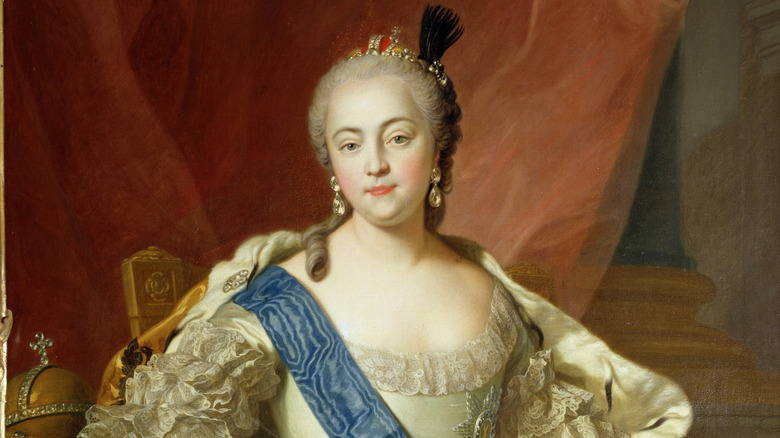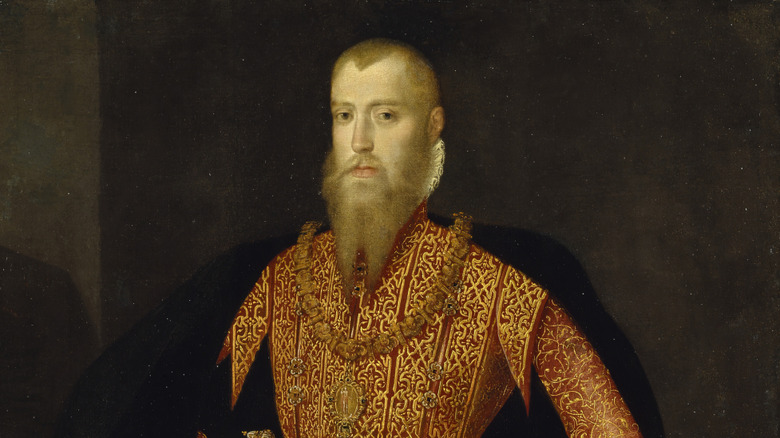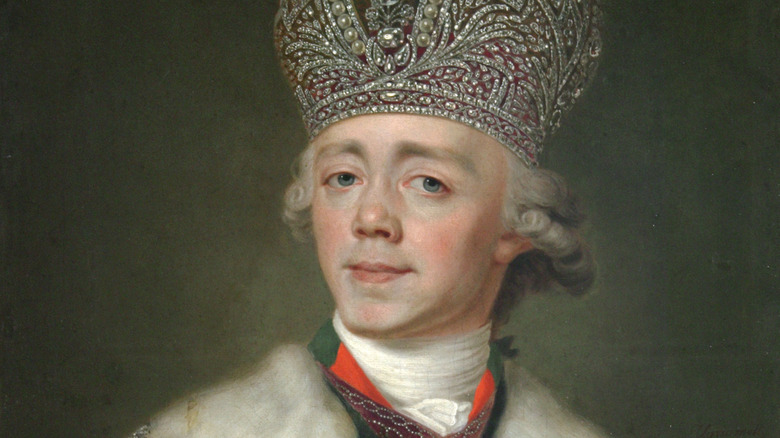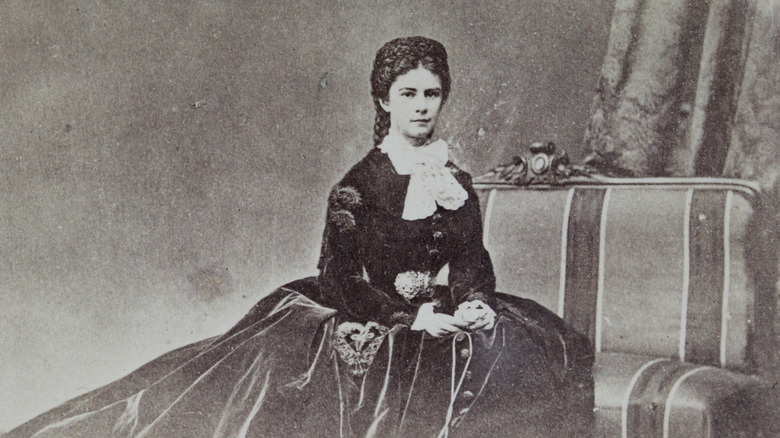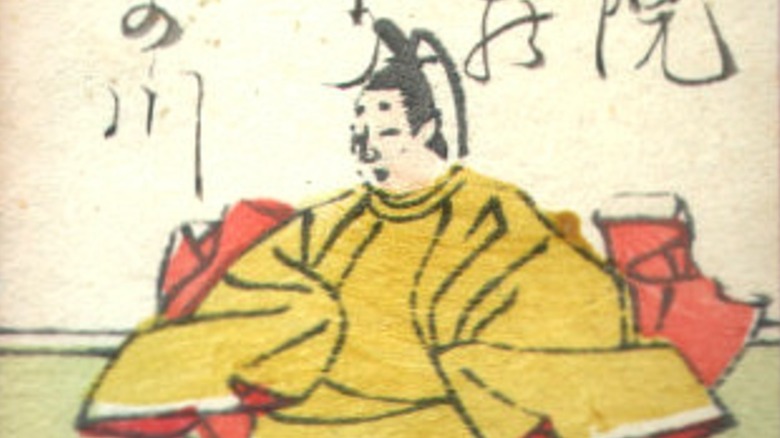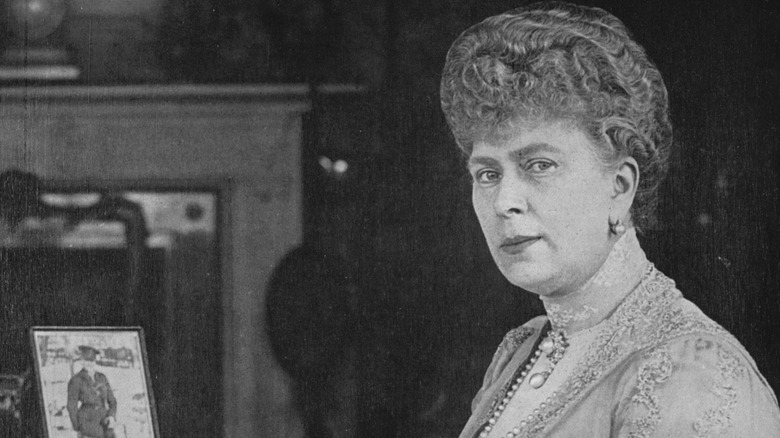Royals Who Were Absolute Nightmares In Real Life
There have probably been very few royals in all of history who were anything approaching "normal." After all, everything about their lives is, by definition, far from ordinary. It's impossible to be raised in an environment where you are seen as being better than other people purely by an accident of birth, and walk away with a pleasant personality and rational way of looking at the world.
With that said, while there were plenty of royals who were totally bizarre people, some were far less fun to be around than others. Those are the ones who didn't just turn out a bit strange, but who were truly unpleasant. In some, this could be as extreme as serious anger management issues that made them lash out at those close to them, even to the point of violence. Or they might have a weird quirk that they didn't keep to themselves, so it became a problem for everyone else at court. Then there were the ones who just never managed to develop a personality, and who even the act of talking to was painful for anyone unlucky enough to be standing near them at a party.
The worst part for the friends, family members, and employees in these situations was that no matter how terrible it was for them, there wasn't much they could do about these royal enfants terribles. Here are some of the royals throughout history who were absolute nightmares in real life.
Peter the Great of Russia
Peter the Great ruled the Russian Empire from 1682 to 1725. He earned his sobriquet by advancing Russia in a number of ways, from the military to science to education and even culture. He left the country a far more modern and powerful place than when he came to the throne. For that reason, despite his despotic reign, he is seen as a successful ruler.
Unfortunately, regardless of how he might have helped the country as a whole, the man was a nightmare for everyone around him. He was curious about any number of subjects, and when he started dabbling in dentistry, this meant courtiers could expect him to pull out their teeth. When he toured Europe in disguise, he destroyed the homes of aristocrats who allowed him to stay there.
Sometimes his excesses ended in tragedy. He was constantly drunk and expected others to get drunk with him. Since Peter was well over 6 feet tall, he could hold his vodka better than others, especially since he liked to pour it down their throats using a funnel. He would position guards at the doors to keep people from leaving. This excessive drinking killed his niece's husband. Peter was also responsible for the death of his oldest son when the young man defied him. Yes, Peter the Great really killed his son. When Peter learned his wife was cheating on him, he had her lover executed, then surprised her by keeping the severed head next to her bed.
Louis XIV of France
Louis XIV, the "Sun King," came to the throne in 1643 when he was just 4 years old, and his reign lasted more than seven decades until he died in 1715. Along the way, he consolidated power around his person. This meant enlarging a hunting lodge into the Palace of Versailles we know today, and forcing every important person in the kingdom to move there and serve him.
This living arrangement allowed for the development of a cult of personality around Louis, which meant that everything he did became a fad. If you were close enough to him or lucky enough to live at court, you could find yourself doing some pretty weird things, so other people would see you were just as cool as the king. For example, Louis enjoyed getting "clysters," now called enemas. He had over 2,000 in his lifetime, sometimes making those at court watch the procedure. In turn, those courtiers could have up to three enemas a day just to stay fashionable.
Then there was the butt surgery. In 1686, the king discovered a lump on his rear. Doctors tried to drain it and do various other things to make the lump — and eventual abscess — go away. Finally, there was nothing left to do but an extremely dangerous surgery. The king survived, which meant the surgery was now fashionable, despite it still being likely to kill the patient. Doctors even had to turn away men who wanted the surgery despite not needing it.
Crown Prince Sado of Korea
Crown Prince Sado was the long-awaited heir to the throne of his father, King Yǒngjo of Korea. But he was taken away from his parents as a young boy and raised by eunuchs and ladies-in-waiting. Sado's wife, Lady Hyegyŏng, wrote decades later that she believed this separation from his family was where all Sado's problems began. When he grew older and was able to attend court functions alongside his father, Yǒngjo would constantly humiliate Sado in public. Unable or unwilling to attack his father for these harsh and embarrassing incidents, Sado took out his problems on those around him.
His wife wrote that Sado's mental problems became obvious by the time he was 10 or 11 (despite their young ages, they were living together platonically by then). Over the years, these issues became worse. The crown prince developed a phobia of clothes, which meant he had to try on outfit after outfit to find one he was comfortable with; if he couldn't, he would lash out, injuring or even killing the servant dressing him. Other times, he did not need a reason to kill eunuchs and ladies-in-waiting. The lucky servants were just made to shout things that were against their religion. Sado also had hallucinations and even threatened the king.
Finally, Yǒngjo took drastic measures. He ordered Sado to get into a large rice chest, which was then sealed shut. The prince died in the chest after several days without food or water.
Elizabeth of Russia
Elizabeth was the daughter of Peter the Great, although several other people ascended to the throne of Russia between his death and when she staged a coup to take power in 1741. She was generally liked by those around her, considered smart and fun, but there was one way in which she drove the court nuts.
The empress was tall for a woman and had very well-built legs. She was aware of how attractive her legs were, but considering giant hoop skirts were in at the time, there was no easy way to show them off. To accentuate them, she would need to wear men's clothes, with their form-fitting breeches and tights. She would often do this when riding her horse, but for some reason, this wasn't good enough. So Empress Elizabeth threw "metamorphosis" balls — as often as twice a week — where everyone who attended had to crossdress.
The future empress Catherine the Great attended these balls when she was married to the heir to the Russian throne. She wrote in her memoirs that all the men at court — princes, generals, politicians — hated these events: "The men did not much like these days of metamorphosis. Most were in the worst possible humor because they felt that they were hideous in their costumes." But Catherine said the women weren't huge fans either, since men's clothes didn't suit their figures or shorter heights. It was just Elizabeth who could carry off the cross-dressing look she required of everyone else.
Philip V of Spain
Philip V was born a French prince but ended up becoming king of Spain in 1700. After the War of the Spanish Succession, Philip was finally secure on the throne, only to give it up in 1724, abdicating in favor of his eldest son. When the boy died just months later, Philip became king again, this time reigning until his death in 1746.
It is rather surprising that Philip was able to hold on to power as well as he did, considering he had serious mental health issues. It is possible he had bipolar disorder, and he exhibited mood swings and periods of depression where he would go to his room, refuse to see people, and stop cleaning or dressing himself. He would also wail for hours in a bad impression of an opera singer.
This was difficult for those around him, but many monarchs have had similar mental health problems throughout history. What really screwed up the court was when Philip decided to swap his sleep schedule, staying up all night and resting during the day. This meant many at court had to keep this schedule as well, from the time the king began it in 1728 until his death 18 years later. This was so taxing that the queen even complained to the French ambassador about it, and she rarely saw her children, who kept normal schedules. Ministers would be summoned for meetings at 2 a.m., and the king would eat dinner at 5 a.m.
Charles VI of France
It's not a great sign when a guy goes down in history as "Charles the Mad." More accurately known as Charles VI, he was king of France from 1380 to 1422. However, his power was limited during much of that time period. This was not his fault, nor was it his fault that those around him found it so difficult to deal with him. In Charles' case, he was mentally unstable.
The king experienced periods of madness throughout his long reign. For his family and those at court, these periods were nightmares. They were not great for Charles, either, and during at least one period of mental instability, he said he would rather die. There were times when Charles thought he was made of glass and would not let anyone touch him in case he broke (while strange, this delusion was more common than you might think; several royals thought they were made of glass). According to a monk, the king once went five months without bathing or changing his clothes, and he ate and slept at unusual hours. If left to his own devices, he would flee the court and run screaming through the streets, so the entrances to his castle had to be sealed shut to make sure he stayed safely inside.
Friedrich Wilhelm I of Prussia
Friedrich Wilhelm I ruled over Prussia from 1713 to 1740. His most notable achievement was probably being the father of the much more famous Prussian monarch Frederick the Great. But during his reign, Friedrich Wilhelm was plenty memorable to those who had the misfortune of interacting with him when he was angry, which was most of the time.
The king was infamous for his quickness to anger and violence. Seemingly anything could set him off; even just mentioning the name of his hated enemy, France, in his presence could send him into a rage. When one of his subjects in the street ran away as Friedrich Wilhelm approached, the king learned this was because the man was afraid of him. The furious monarch hit the terrified man, demanding that he love his king. On being told that a post office was closed because the postmaster overslept, the king entered the postmaster's home and thrashed him. When Friedrich Wilhelm disagreed with the rulings of some of his judges, he beat them so hard they lost teeth.
The king was particularly horrible to his son, Frederick. Even contemporaries who were used to seeing fathers be harsh on their sons were shocked at how cruel Friedrich Wilhelm could be. Frederick would send his father letters begging to know why he hated him so much. Friedrich Wilhelm even blamed his son for letting him treat him so badly, saying that he – Friedrich Wilhelm — would never have stood it from his own father.
Gustav I Vasa of Sweden
When Sweden won its independence from Denmark in 1523, Gustav I Vasa was elected the first king of the newly freed country. While there must have been something in him that made those around him (or at least those important enough to get to vote on who became king) see that Gustav had leadership qualities, he also had serious anger management issues. According to "The Madness of Kings," his enemies referred to him as "a tyrant and a bloodhound." While one can never trust the opinions of an enemy to be fair and accurate, it is likely that his own family and others around him felt the same way.
To be within arm's reach of the king was to be in physical danger, as he was routinely violent, and some people chose exile rather than risk staying near the seemingly mad king. In an incident that went down in Swedish history as "the Vadstena Thunder," Gustav grabbed his daughter, Princess Cecilia, by the hair and ripped it out by the root when a man was found in her bedchamber. When a secretary did something to upset him, the king grabbed a knife and ran after the terrified servant.
The princess and the secretary had been lucky. Others who faced the king's wrath did not survive the encounter. Once, a jeweler made the mistake of taking a vacation. When Gustav found the man was unavailable when he needed him, he beat the jeweler so badly that he died.
Erik XIV of Sweden
Sweden might have been thrilled to win its independence from Denmark in 1523, but its first two kings left a lot to be desired. Like his father, Gustav I Vasa, son and heir Erik XIV was angry and violent. (Erik chose XIV as his regnal number because there had been previous kings of Sweden of that name centuries before.) But Erik's rage was tinged with a paranoia that his father lacked: He saw conspiracies everywhere, from the tiniest infractions to actual important incidents.
Erik believed everyone was out to get him, to the point of obsession. One man was arrested for painting the king's coat of arms upside down. He accused his servants of trying to undermine him when he misplaced the notes of a speech he was about to give. Wearing clothes he thought were too fancy, clearing your throat, whispering, or leaving items lying around that annoyed the king could lead to serious consequences or even death.
Being family made no difference when it came to Erik's wrath and paranoia. He had his brother John, who Erik worried might be after some of his power, thrown in prison when he married a woman the king did not approve of. His new wife was also jailed. Erik especially did not trust the Swedish aristocrats and routinely had them arrested or executed. In the most extreme example, Erik jailed and then personally stabbed to death Nils Sture, an aristocrat he incorrectly believed had betrayed him.
The Duke of Windsor
The abdication of Edward VIII was one of the craziest scandals in British royal family history. When he fell in love with Wallis Simpson — an American who had already been divorced once and was in the process of divorcing her second husband — Edward was still only the Prince of Wales. But when he became king in 1936, it became clear to everyone that it was Wallis or the throne, and he chose Wallis. He was given the title Duke of Windsor and left England to live the life of a bored, rich aristocrat for the next few decades.
This meant that he jetted around the world, where he met and partied with other rich people. Some of them might already have been bored as well, but once they were unlucky enough to end up in conversation with the duke, they discovered new realms of boredom never thought possible. Composer Noël Coward said that the duke even managed to dance a dull Charleston. In his memoir "Palimpsest," writer Gore Vidal snarked that the duke "always had something of such riveting stupidity to say on any subject that I clung to his words like the most ardent courtier of the ancien régime."
Not even the future duchess was exempt from the duke's astonishing abilities to bore people around him half to death. According to Wallis' recollection, her first conversation with her future husband was about central heating. She even called him out for bringing up such a dull topic.
Paul I of Russia
After Catherine the Great died, her son became Paul I of Russia, and while Catherine was a brilliant ruler, Paul was not. Among other issues, he was paranoid and single-minded. Even as a child, his failings were evident. His tutors remember him as an intelligent child, but any random thing could make him spin out of control. When his first wife died, he smashed up his furniture and refused to allow anyone to bury her until his mother intervened. Once he took the throne, these concerning tendencies became everyone else's problem as well.
Almost immediately, the new tsar started making laws that controlled the lives of his subjects in the smallest and most unimportant ways. Paul forced his subjects to follow a strict dress code, with troops sent to patrol the streets looking for those who were not appropriately attired. They would rip the clothes off men and women alike. Women were also required to throw themselves face down in the street if Paul's carriage came by. Anyone who walked past the royal palace had to remove their hat, even if the tsar was away. Paul even banned entire words from the Russian language.
A close friend of Paul's, Count Feodor Rostopchin, wrote, "He is obsessed with the idea that people do not respect him and that they scorn him. ... The slightest tardiness, the slightest contradiction put him beside himself, and he is inflamed with rage" (via "Secret Lives of the Tsars"). Perhaps unsurprisingly, Paul was assassinated in 1801.
Princess Alexandra Amalie of Bavaria
Princess Alexandra of Bavaria is another royal whose bizarre lifestyle affected those around her through no fault of her own. Historians now theorize that she may have had obsessive-compulsive disorder or something similar. While it is impossible to be sure about the mental issues facing a woman who died in 1875, many of the tendencies she exhibited seem to match up with modern issues faced by those with OCD.
For example, Alexandra was obsessed with cleanliness. At a time when bathing was less frequent than it is today, she would only wear white to make sure she could see any dirt that touched her. She also believed she had swallowed a glass piano as a child, and it would shatter if anyone touched her. This required that she walk carefully through the palace, especially making sure that she never bumped into a doorway.
While it might sound funny now, it was clear to those around her how much Alexandra's life was affected by her mental issues. Her father never allowed her to marry because of them, and when she died aged 49, her nephew, King Ludwig II, wrote, "Although it is always painful for the survivors when a member leaves the family circle forever, it really was a very good thing in the case of dear Aunt Alexandra. Her continuous sufferings from her nervous disease were seldom interrupted by moments of happiness" (via "Royal Inbreeding and Other Maladies: A History of Royal Intermarriage and Its Consequences").
Ernest Augustus of Hanover
Ernest Augustus was the fifth son of George III of England, but because of various rules around illegitimate children and women inheriting the throne, he ended up first in line to become king of Hanover, in Germany, in 1837. He was said to be the most intelligent of his brothers, but he ruined this by being a completely unpleasant person.
During his own lifetime, there were rumors that made Ernest Augustus sound like a psychopath. People said that he had sexually assaulted his sister, murdered his valet, drove a man to death by suicide after having an affair with his wife, and much more. The good thing, for the purported victims of these horrible deeds, is that none of the rumors were true, with most of them invented by Whig politicians who did not agree with Ernest Augustus on policy. What is true is that he was considered so unpleasant by everyone who met him that the public easily believed all of it.
Indeed, Ernest Augustus was thoroughly unlikable. He fought with Parliament for not raising his royal allowance, and he was involved in enough questionable dealings that he left England for 10 years in a semi-voluntary exile. In 1828, he returned and then immediately tried to tank an important piece of legislation because of his bigotry towards Catholics. Once he became king of Hanover, he ripped up their constitution and ruled with a much harder fist. By the time he died in 1851, the people of that country hated him too.
Ivan the Terrible of Russia
Ruling Russia from 1547 to 1584, Ivan the Terrible's sobriquet was not meant to be ironic. He was a tyrant who crushed the people of Russia under his boot, employing his own royal kill squad that would slaughter whole towns at a time. But he was not simply a ruler reveling in his ironclad over the little people — he also treated the members of his family horrifically, especially the women.
In Ivan's worldview, women were utterly disposable. He married somewhere between five and eight times, discarding wives as he saw fit, which might be why no one is sure of the exact number he got through. His first three wives all died, the last two in quick succession, making some people question if he had something to do with their deaths. Two further wives were sent to a convent, and there were rumors of a wife who only lasted one night before he had her drowned. He took a similar approach with his eldest son Feodor's marriages, forcing one daughter-in-law to become a nun, then repeating this with the daughter-in-law who replaced her. Ivan also lashed out at the pregnant wife of his other son for wearing clothes he disapproved of; the beating caused a miscarriage.
While it was usually the women of his family that the tsar was tormenting, the most violent incident involved his son, Ivan. When the younger Ivan confronted his father about his wife's miscarriage, the elder Ivan beat him to death.
Elisabeth of Austria
Elisabeth of Austria, more commonly known as Sisi, is often considered one of the hottest famous people from history. She married the future emperor of Austria when she was just 16 and found herself in a repressive court where she had no control. Knowing her only power was her looks, she took control of them to an obsessive and dangerous degree. Coming up with ways to stay beautiful took up most of her time.
Elisabeth had a gym installed in her rooms at the palace and worked out daily, at a time when working out was very uncommon even for men. She rode horses to keep herself thin as well, and it is believed she was anorexic. Elisabeth even saw motherhood as a negative, according to her niece, who claimed Elisabeth once said, "Children are the curse of their mothers because they destroy their beauty ... the sole and unique gift that God gives us" (via Simone de Beauvoir Studies). But youth and beauty fade. As she got older, Elisabeth refused to let people look at her, including her bodyguards, which made their job extremely difficult. In photos, she would cover her face with a fan. She stopped sitting for portraits.
Instead, she began to travel extensively, which caused new problems for others. On these journeys, Elisabeth would force her way into homes across Europe uninvited, from ordinary people's houses to royal palaces. Her quest for eternal beauty ended in 1898, when Empress Elisabeth of Austria was tragically assassinated. She was 60 years old.
Yōzei of Japan
Yōzei, the 57th emperor of Japan, was only 9 years old when he came to power in A.D. 876. While he would live to be 81, he was removed from the Chrysanthemum Throne while still a teenager after ruling for a mere eight years. This was because, by that point, everyone around him had realized he was a psychopath.
While it is hard to know what stories are fact, since there is very little record remaining of his short reign, it is clear that Yōzei was violent and homicidal. Allegedly, as a young child he liked to watch animals kill each other, then moved on to killing animals himself. He would ride through towns on his horse, whipping passersby. He would abduct young girls, tie them up, and throw them in lakes. He forced one of his courtiers to climb a tree and poked at him with his sword until the man fell and died.
There are hints and rumors of other murders, but it was this last act that seems to have been the final straw for those around the emperor. Yōzei's uncle Mototsume was regent for the boy and used his influence to remove the mentally disturbed teen from the throne in 884. But even in retirement, Yōzei was seen as a serious danger. The Emperor Uda, who took the throne three years later, even formed an elite unit of bodyguards to protect him from the threat of the former ruler.
Mary of Teck
There is much argument among historians about whether it is accurate to call Queen Mary, wife of England's George V, a full-blown kleptomaniac. She certainly liked things, such as knick-knacks and pieces of furniture, especially if they had any connection to her family. She wrote to her aunt in 1909, "It is really rather wonderful what [George and I] have managed to collect & get together since we married, quite a creditable collection of family things ... without spending much money over it. I confess I feel rather proud of our endeavors" (via Vanity Fair).
It is also clear that she was often slow to pay for these items, if she paid at all. Shopkeepers in London were said to complain that the queen was a frequent shopper but rarely paid her bills in a quick fashion.
Some historical rumor goes further, however, and claims that the queen had a technique for getting people to give her items they owned as gifts. She would fawn over the piece she liked, pushing harder and harder if the offer to take it was not forthcoming. If it never came, and the item was small enough, some say she would just put it in her handbag before she ended her visit. Even if these rumors are true, Kleptomania requires a pathological element that Mary seems unlikely to have had. She may just have really liked other people's stuff and thought they should give it to her.
If you or anyone you know may be the victim of child abuse, is dealing with domestic abuse, needs help with an eating disorder, or needs help with mental health, contact the relevant resources below:
-
The Childhelp National Child Abuse Hotline at 1-800-4-A-Child (1-800-422-4453) or contact their live chat services.
-
The National Domestic Violence Hotline at 1−800−799−7233. You can also find more information, resources, and support at their website.
-
The National Eating Disorders Association website or contact NEDA's Live Helpline at 1-800-931-2237. You can also receive 24/7 Crisis Support via text (send NEDA to 741-741).
-
The Crisis Text Line by texting HOME to 741741, call the National Alliance on Mental Illness helpline at 1-800-950-NAMI (6264), or visit the National Institute of Mental Health website.
